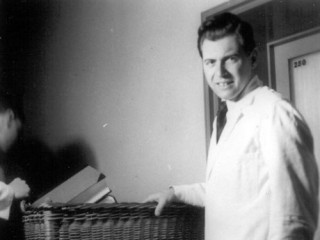
Josef Mengele biography
Date of birth : 1911-03-16
Date of death : 1979-02-07
Birthplace : Günzburg, Kingdom of Bavaria
Nationality : German
Category : Historian personalities
Last modified : 2010-11-22
Credited as : Nazi doctor, experimented Aryan perfection, The Angel of Death
5 votes so far
Josef Mengele, also known as the Angel of Death (Todesengel in German) was a German SS officer and a physician in the Nazi concentration camp Auschwitz-Birkenau. He earned doctorates in anthropology from Munich University and in medicine from Frankfurt University. He initially gained notoriety for being one of the SS physicians who supervised the selection of arriving transports of prisoners, determining who was to be killed and who was to become a forced labourer, but is far more infamous for performing grisly human experiments on camp inmates, for which Mengele was called the Angel of Death.
In 1940, he was placed in the reserve medical corps, following which he served with the 5th SS Panzergrenadier Division Wiking in the Eastern Front. In 1942, he was wounded at the Russian front and was pronounced medically unfit for combat, and was then promoted to the rank of SS-Hauptsturmführer (Captain) for saving the lives of three German soldiers. He survived the war, and after a period living incognito in Germany he fled to South America, where he evaded capture for the rest of his life despite being hunted as a Nazi war criminal.
Known as The Angel of Death, Dr. Josef Mengele was the chief doctor at the Auschwitz concentration camp during the Second World War.
Mengele was born in March 1911 into a wealthy Bavarian family, with a strict Catholic upbringing. He studied philosophy in Munich, where he encountered the racial ideology of Alfred Rosenberg.
In 1931, at the age of 20, he joined the Stahlhelm (Steel Helmet), then the SA in 1933, and applied for party membership in 1937. Upon being accepted into the Nazi party, he applied for membership in the SS.
He later studied medicine at the University of Frankfurt, after which he joined the Institute for Hereditary Biology and Racial Hygiene in 1934. It was here that he developed his studies in physical anthropology and genetics.
Prior to his arrival at Auschwitz, he had published significant articles on genetic abnormalities and racial variations in primary features.
His career in academia looking bright, but the war interrupted his progress, and he was placed with reserve medical corps and a Waffen SS unit. Wounded, he was declared unfit for combat, but promoted to captain.
An ardent Nazi, he served as medical officer with the Waffen SS during WW2, and was appointed chief doctor at the Auschwitz concentration camp where Jews were selected either for labour, extermination or medical experimentation.
He became known as the ‘Angel of Death’, in charge of vast numbers of fatal, bizarre and brutal medical experiments which killed over 400 000 victims.
Controversy surrounds the outcomes of such horrific experiments, as their occasionally sophisticated findings have proved of undeniable use, for example, in the development of thinking on hereditary genetics and DNA.
After the war, he escaped, apparently surfacing in South America in 1961, where he met another Nazi, Wolfgang Gerhard, in Brazil.
Recent forensic advances, involving a body exhumed in 1985, suggest that he had assumed Gerhard’s identity upon his death, and was buried under that name.
















